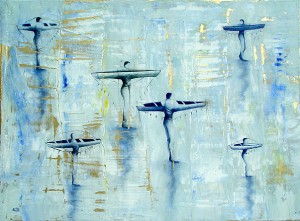« Reviews
Contemporary Fables by Humberto Castro

Humberto Castro. Sailors, 2008. Oil/Canvas 42" x 56.5". Courtesy of ArtSpace/Virginia Miller Galleries, Coral Gables (Miami), Florida.
ArtSpace / Virginia Miller Galleries, Coral Gables - Miami
October 3 - 30, 2008
By Ernesto Menéndez Conde
Since the mid-nineteen eighties, when the Cuban painter Humberto Castro first exhibited his art in Havana, the human body has been the leitmotiv that gives continuity to the several stages of his work. Man has been the main topic of his art. Through the human body, sometimes isolated and lost in an enigmatic environment, Humberto Castro offers images of the existential and psychological incertitude, which seems inherent to man in contemporary societies. His paintings and installations are related to the lack of communication, loneliness, and aggressiveness of man in today’s world. His new show, “Contemporary Fables,” which was inaugurated at the ArtSpace/Virginia Miller Galleries, goes in a subtle new direction. Castro explores the role of unconsciousness, and the daydream in our everyday life.
It was not by chance that the place of ancient myths (such as Oedipus, Narcissus, Orpheus, or Leda) in contemporary life was stressed by American abstract expressionists, following Freud, and the surrealists. Myths in contemporary life are always related to an existential anguish, which American artists expressed through violence, randomness, and chaos. In “Contemporary Fables,” Castro uses expressionistic brush strokes and textures in the backgrounds, but existential anguish is present mostly in the form of the uncanny. His enchanted world is both lyrical and hostile at the same time.
“Contemporary Fables” are tales of the absurd. They depict images, which seem to be pieces of an indecipherable nightmare. In these new paintings, the sense of space is rather poetical and suggestive. There is also an iconography which has to do with the logic of the dream: figures floating in a sort of void; men lost in circular, threatening forests; hybrids of boats, animals, men and branches of trees. Unlike the works Humberto Castro made in Cuba, in which colour was rendered with violence and sharp contrasts of primaries, here there is a tendency to solving the painting with a monochromatic unity, after covering the canvas with a first layer of golden colour. If Castro’s paintings from the mid-eighties could be seen as a cry or an outbreak, these new canvases could be regarded as an expression of silence, fears, and introspection.
Filed Under: Reviews


































